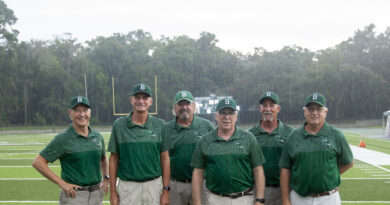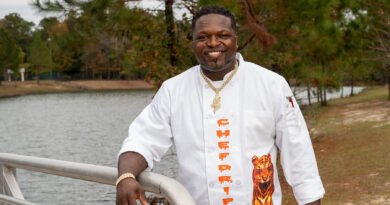Frank Roberts A Passion for Cultivating Oysters
story by carol lauvray photography by paul nurnberg
Oystering is in Frank Roberts’ DNA. His ancestors began harvesting oysters in the wild in the Chesapeake Bay in the 1700s, where the bivalve mollusks were once so prolific that they could filter and purify all of the water contained in that bay in just two days. Frank says that each 3-inch to 4-inch oyster can filter up to 50 gallons of water a day, so oysters are a key to maintaining a healthy coastal ecosystem.
Like his forefathers, Frank grew up along the East Coast harvesting oysters in the Chesapeake Bay and Long Island Sound. In 1981, he came to Parris Island as a Marine Corps recruit—his first introduction to the Lowcountry and its pristine estuaries where oysters abound. In October 1983 while in the service, Frank left his Marine barracks near Beirut airport on a covert mission as a sniper. “I was the one who wasn’t supposed to make it,” Frank recalled, “but just after I left on the mission, a truck filled with explosives drove into the barracks killing 241 Marines in my unit.” Frank left the Marine Corps in 1985 and became a police officer in New Haven Connecticut, working the nightshift. In addition to working as a policeman, Frank was part of the FBI’s violent crimes task force targeting narcotics traffickers. During the daytime though, (for what he calls “sanity maintenance,”) Frank would visit oyster hatcheries to do research and learn the science of mariculture—raising oysters. One day he looked through a microscope lens and saw minute oyster larvae feeding, and he was hooked.
Frank moved to Beaufort full-time in the early 2000s to pursue his new, less stressful career, cultivating oysters, and has been doing that since 2007 with his business Lady’s Island Oysters, Inc., located near the Coosaw and Whale Branch Rivers. A pioneer in Lowcountry mariculture of oysters, Frank says getting started was a complex process. Working out the lease arrangements with the South Carolina Department of Natural Resources took some time, and developing his signature Single Lady Oysters—large individual oysters (not the clusters usually sold)—took years of research to perfect. Single Ladies are 3-inch to 4-inch, single-shell oysters raised for their ideal wide-fan shape and proportions. And according to the company’s website, they have a unique taste—“a smooth briny start with a sweet clean finish,” that many proclaim to be the best oysters they’ve ever eaten. Frank attributes the pure salt-waters flowing directly from the Atlantic into the Saint Helena Sound estuary as a primary reason for the outstanding flavor of his oysters. He’s also developed another type of specialty oyster, Phat Ladies, so called because they are larger with a deeper cup and greater meat content. All of the Phat Ladies that his company raises are sold to a single restaurant in Charleston, S.C., The Ordinary. Last year Frank delivered 40,000 Phat Lady Oysters to that restaurant.
Lady’s Island Oysters has grown substantially. Now eight oyster growers work at the company, using seven boats to harvest the oysters when they are mature and ready for market. Frank’s family—his wife Karen, daughter Katelyn, and son Christopher—are all involved with the business too. Katelyn even spawned her own brood of 42,000 oysters to earn money to feed and care for her horse. The oyster operation at 35 Hutson Place, near the Whale Branch Schools on U.S. Route 21, involves a complex, multi-step process that requires just 10 to 14 months to grow oysters from seed to mature oysters (please see the sidebar article for details). Frank says, “Our Single Lady Oysters go from here (the larva stage in the nursery) to the raw bar and beer in just a year!” In the wild, oysters take three years to complete the same growth process and they experience a much higher mortality rate—less than one-half of one percent of the oysters in the wild will survive from the larva stage to maturity. However, six percent of the oyster larvae that Frank’s company develops mature into adult oysters and go to market.
Oysters feed by extracting algae and other food particles from the water that they almost constantly draw over their gills. In the wild, they reproduce when the water warms by broadcast spawning and will change gender once or more during their lifetime. They are extremely sensitive to water quality and susceptible to coastal pollution, and populations in many areas where they were once abundant have dwindled or disappeared. (Source: www.NationalGeographic.com).
So what is Frank’s secret to raising his high-quality oysters with a much better survival rate than oysters in the wild? He attributes his success to the Lowcountry estuary environment, to his years of research and learning what works and what doesn’t, and to carefully controlling the process. He says growing oysters is both an art and a science, “Our oysters spawn a lot and they grow fast in the protected, food-rich environment we provide.” Frank said he has developed a special recipe of filtered seawater and microalgae to nourish the microscopic oyster larvae he raises. “We treat it like it’s like a secret seasoning recipe for barbeque,” Frank said jokingly, but at the same time he was totally serious. “Our secret recipe is a variety of concentrated phytoplankton that we feed our oyster larvae.”
It’s fascinating to see the minute oyster larvae in action, moving around under a microscope magnifying at 100 times actual size. Frank notes that you can determine the health of the larvae by looking through the lens to see if their digestive tracts are translucent and have food in them, and whether the water conditions are good. You can actually watch the larvae take in nutrients and see if they have begun to form their own shells from the calcium contained in the crushed oyster shell in the water that surrounds them. “Its like a little city of activity,” Frank exclaimed, “I could watch this all of time!”
Frank proudly states, “Lady’s Island Oysters are hand-crafted oysters—touched many times by human hands to produce the highest quality oysters for the finest restaurants, whose chef-owners want to feature a local, sustainable farm-to-table product.” He says he sells 98 percent of his Single Lady Oysters to Charleston restaurants, and the rest to restaurants in Beaufort (The Old Bull Tavern, Saltus River Grill, Wined It Up, and Foolish Frog), Poseidon Coastal Cuisine on Hilton Head Island, Chechessee Creek Club in Okatie, and to the general public. You can find Frank at the Port Royal Farmers Market on Saturday mornings from 9 a.m. to noon selling his Single Lady Oysters for $1.00 each, so you can take them home to experience this Lowcountry delicacy for yourself.




